Berchtold Elektrotom 610 User manual
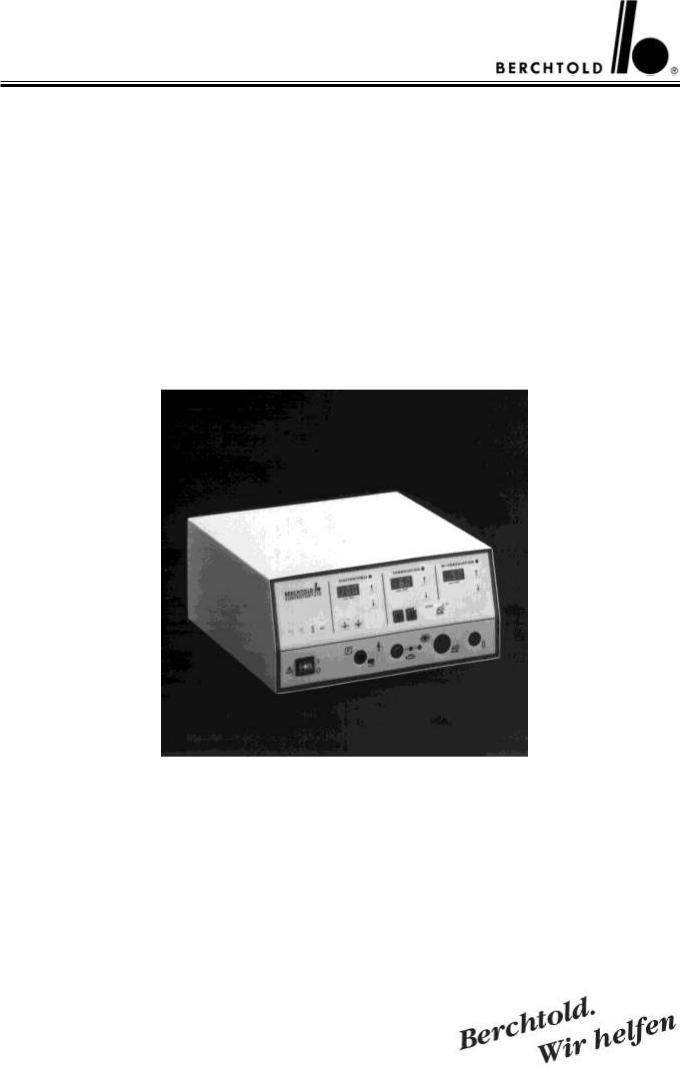
ELEKTROTOM® 610
Operating Instructions
Valid from version 1130

Contens |
|
Page |
||
1. |
Introduction |
4 |
|
|
2. |
Routine checks following delivery |
5 |
|
|
3. |
Initial installation |
5 |
|
|
4. |
First usage |
5 |
|
|
5. |
Important notes for safe usage |
5 |
- 9 |
|
|
5.1 |
Positioning of the patient |
6 |
- 7 |
|
5.2 |
Application of the negative electrode |
7 |
- 8 |
|
5.3 |
HF electosurgery with heart pace-maker patients |
8 |
|
|
5.4 |
Important points during intracardial procedures |
8 |
- 9 |
|
5.5 |
The use of foot-switches |
9 |
|
6. |
Surgical indications |
9 |
|
|
7. |
Principles of electrosurgery and techniques |
10 |
- 12 |
|
|
7.1 |
Monopolar techniques |
10 |
|
|
7.1.1 |
Cutting |
10 |
|
|
7.1.2 |
Coagulation |
10 |
- 11 |
|
7.2 |
Bipolar techniques |
11 |
|
8. |
Function of the ELEKTROTOM® 610 |
11 |
- 19 |
|
|
8.1 |
Current types for 3 cutting modes with differing effects |
11 |
- 13 |
|
8.2 |
Current types for 2 monopolar coagulation modes with differing effects |
13 |
- 15 |
|
8.2.1 |
Forced Coagulation |
13 |
|
|
8.2.2 |
Soft Coagulation |
13 |
- 14 |
|
8.3 |
Bipolar Coagulation |
15 |
- 16 |
|
8.4 |
Safety relevant function |
16 |
- 18 |
|
8.4.1 |
Computer supported safety features |
16 |
- 17 |
|
8.4.2 |
Neutral electrode monitoring |
17 |
- 18 |
|
8.4.3 |
Protection against unit malfunction |
18 |
|
|
8.4.4 |
Protection against erroneous unit settings |
19 |
|
9. |
Operating the ELEKTROTOM® 610 |
20 |
- 24 |
|
|
9.1 |
Puhsbuttons and signal lights |
20 |
- 24 |
|
9.1.1 |
The front of the ELEKTROTOM® 610 |
20 |
|
|
9.1.2 |
The rear of the ELEKTROTOM® 610 |
21 |
|
|
9.1.3 |
Description of the puhsbuttons and symbols |
22 |
- 24 |
10. |
Commissioning |
24 |
- 25 |
|
|
10.1 |
HF current interference |
24 |
- 25 |
|
10.2 |
Using multiple functions |
25 |
|
11. |
Visual and functional checks before each use |
25 |
|
|
2 |
ELEKTROTOM® 610 version 1130 Operating Instrutions |

Contens |
|
Page |
||
12. |
Accessories |
26 |
|
|
|
12.1 |
Standard accessories for mono-terminal incision and coagulation by means of a |
26 |
|
|
|
double finger-switch |
|
|
|
12.2 |
Additional accessories for mono-terminal incision and coagulation by means of a |
26 |
|
|
|
double finger-switch |
|
|
|
12.3 |
Additional accessories for mono-terminal incision and coagulation by means of a |
26 |
|
|
|
double foot-switch |
|
|
|
12.4 |
Standard accessories for bipolar coagulation |
26 |
|
13. |
Cleaning, disinfection and sterilisation |
27 |
|
|
|
13.1 |
Cleaning and disinfection of the unit |
27 |
|
|
13.2 |
Cleaning, disinfection and sterilisation of accessories |
27 |
|
14. |
Repairs |
27 |
- 28 |
|
|
14.1 |
Replacement of fuses |
28 |
|
15. |
Technical safety controls |
28 |
|
|
16. |
Guarantee |
29 |
|
|
17. |
Notes on product responsibility |
29 |
|
|
18. |
Technical description |
30 |
- 31 |
|
|
18.1 |
Technical data |
30 |
- 31 |
|
18.1.1 |
Mains connection |
30 |
|
|
18.1.2 |
HF current output and current characteristics |
30 |
- 31 |
|
18.2 |
Safety relevant data |
31 |
|
|
18.3 |
Equipment for user support |
31 |
|
|
18.4 |
Dimensions and weight |
31 |
|
|
18.5 |
Certificationt |
31 |
|
19. |
Power output diagram |
32 |
- 34 |
|
|
19.1 |
Power output in relation to resistance (output characteristic) |
32 |
- 34 |
|
19.1.1 |
Current type CUT I |
32 |
|
|
19.1.2 |
Current type CUT II |
32 |
|
|
19.1.3 |
Current type FORCED COAGULATION |
33 |
|
|
19.1.4 |
Current type SOFT COAGULATION |
33 |
|
|
19.1.5 |
Current type BIPOLAR COAGULATION |
34 |
|
ELEKTROTOM® 610 version 1130 Operating Instructions |
3 |

1 Introduction
.
Electrosurgery belongs to the most important energy applications in surgery. In all surgical disciplines, it remains the most effective means of combining tissue cutting and haemostasis. The electrosurgical unit, the ELEKTROTOM® 610 electrosurgical unit is a modern instrument combining economy with a considerable degree of operative flexibility. The unit has a capable output of 100 Watts.
Particularly important features of the ELEKTROTOM® 610 include:
•Enhanced user simplicity and safety via integrated microprocessor technology
•Two current types offering excellent cutting qualities combined with simultaneous haemostasis
•Bipolar coagulation with up to 50 Watts output
•Effective, contact coagulation with 60 Watts output for both standard, and micro-arc free soft coagulation with 60 Watts
•User friendly control panel with foil covered pressure pads and digital read-out display
•The highest degree of safety using modern, negative electrode monitoring technology, for both single and split negative electrodes
•A malfunction, error code display system, showing user information and offering assistance during service and repair procedures
These and other advantages of the ELEKTROTOM® 610 will be discovered when studying these instructions for use and employing the correct accessories and features of the unit in the manor for which they have been developed.
4 |
ELEKTROTOM® 610 version 1130 Operating Instrutions |

2 Routine checks following delivery
.
The product and accessories should be inspected for possible transport damage or other defects immediately on arrival.
Reclamation regarding damage or defects can only be entertained by the selling organisation (Berchtold GmbH & Co.) or the delivering agency when they are immediately reported. In case of complaint, the forwarding agent or the Berchtold sub-agency must immediately be informed, prior to the submission of a damage / deficiency report to the Berchtold main offices in Germany for further processing by our insurance agents.
When returning a unit or one of its components to Berchtold or to a Berchtold service centre, every effort should be made to use the original packaging material. The following information/documentation must also accompany the returned items:Name and address of the owners, product identification number (See plate affixed to unit), Detailed description of the defect.
3 Initial installation
.
The unit is intended for use only in a medical environment and connection to the mains must be in accordance with the IEC 364-710 regulations. Further, connection to the mains should be via a suitably protected socket using the mains lead and plug provided by the manufacturer or one of an equivalent quality. For safety reasons, extension leads or multi-socket connections should not be used. The mains socket must be protected by a fuse rated at not less than 10 Amperes.
The ELEKTROTOM® can be placed on any flat surface with a tilt angle not in excess of 10°. The surface itself should be equivalent in size to that of the unit. Care must be taken not to block the air vents on the underside of the generator and ensure a free flow of air around the unit. The ELEKTROTOM® should be protected from the danger of fluids entering the unit.
The generator is at intracardiac interventions supplied with a cable to balance earth potential. This should be connected to the appropriate connector in the operating theatre in order to avoid 'static' shocks when handling various apparatus.
For intracardiac surgery this equipment must be connected to the main power stabilizer in the operating room or location where it is installed by means of the (yellow/green) power-stabilization cable supplied.
4 First usage
.
Before the unit is first used surgically, the Manufacturer or their official agent shall:
a)have fully tested the unit in the position in which it is to be used;
b)have given full operational instructions for the unit to a responsible person.
5 Important notes for safe usage
.
ELEKTROTOM® 610 version 1130 Operating Instructions |
5 |

Misuse of the generator and a disregard of these instruction can lead to serious injury!
Take care to study these instructions supplied with your ELEKTROTOM
Warning!
The unit is not intended for use in explosion endangered areas.
Caution must be exercised when anaesthetic gas mixtures such as Oxygen (O2) and nitrous Oxide (N2O) are used during surgery in the thoracic or head regions. The use of anaesthetic gas, exhaust management systems is to be
6 |
ELEKTROTOM® 610 version 1130 Operating Instrutions |
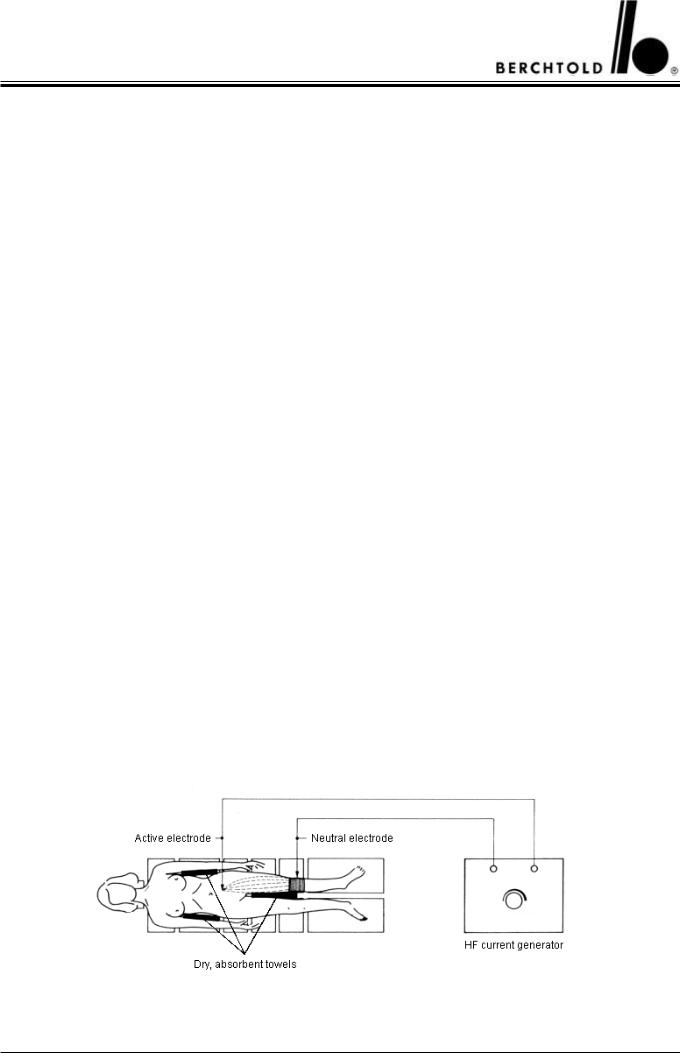
recommended. Inflammable substances used for cleaning or disinfection or, particularly, solvents used to remove adhesives, must be removed or fully evaporated before the using an electrosurgical unit. The danger of pocketing or pooling of inflammable liquids or vapours in body cavities such as the navel or vagina as well as in the depths of surgical wounds which must also be considered and not underestimated. Liquids must not be allowed to gather or pool under the patient. The presence of endogenic gases which may be ignited, must also be taken into account when using electrosurgical equipment on the gut and a system of inert gas flushing is recommended. Material such as cotton wool or gauze can, in certain circumstances, also be ignited via HF current induced sparking - particularly in the presence of oxygen.
The use of electrosurgery requires caution and the following rules should be considered:
•The high frequency current output of the unit should be minimal and not more than is required for the task to be performed.
Note:
A reduced or lack of function after setting the unit output controls at 'normal' power can be caused by a number of factors such as neutral electrode problems, bad connections, damaged cables or a crusted active electrode. Theses point should be considered before selecting what might be a much higher unit output than necessary.
•Do not attempt to test the unit by directly discharging against a metal object or the negative electrode.
•The function of other electromedical equipment can be interfered with by the use of high frequency current.
•The function of other electromedical equipment can be interfered with by the use of high frequency current.
•In order to prevent accidental HF current burns, the electrode handle should be placed on the instrument trolley when not in use and not on the patient.
•Placing a finger switched, electrode handle onto very damp drapes or, into pooled liquid on the drapes, may cause patient burns directly below the electrode handle.
5.1 Positioning of the patient
•The patient must be isolated from any earth contact via metal parts of the operating table, or other equipment such as drip stands, by the use of dry, non conductive material. There must be a water proof layer between the patient and the operating table cushions.
•Areas of the patient subject to wetting from sweat or other fluids must be protected from HF current.
•In order to prevent 'pooling' the water-proof layer under the patient should be covered by absorbent material.
ELEKTROTOM® 610 version 1130 Operating Instructions |
7 |

•Body areas which are particularly subject to sweating (such as where there is a direct skin to skin contact - between the legs, arms and trunk, breasts etc.) should protected by the use of inter-placed absorbent towels.
5.2 Application of the negative electrode
In monopolar electrosurgery, the negative electrode serves to safely complete the electrical circuit with the HF current generator. In order to avoid thermal irritation or burning the contact area of the negative electrode with the skin must be large enough to pose the minimum of electrical resistance. For patient safety reasons, operating theatre personnel should study the following instructions for the application and fixation of the negative electrode.
= Operating site
•The negative electrode should be placed as near to the operating site as is practicably possible. Normally, on the nearest limb. It is of great importance that the full surface of the electrode makes contact with the skin and that it is secured (without undue pressure) in position.
•The electrode should not be applied over scar tissue, bony protuberances, implanted prostheses or areas of excessive, subcutaneous fatty tissue. Areas where fluids may "pool" MUST be avoided.
•The application area must be free of injury, clean, dry and free of excessive hair growth.Alcohol should not be used to clean the area.
•Electrode contact jelly (gel) should NOT be used.
•The electrode cable should be selected to be as short as possible. It should lead directly to the generator and be free from coils. A physical contact between the cable and the patient and or other cables should not occur.
•An apparent lack of generator power or other malfunction noticed at the active electrode may indicate a misplacement of the neutral electrode or a poor return of current from it to the generator. The danger particularly exists following a re-positioning of the patient intraoperativley.
•Other electrodes (E.C.G., etc.) or electronic sensors must be isolated against earth potential. (Floating input)
•Do not pull on the negative electrode cable.
8 |
ELEKTROTOM® 610 version 1130 Operating Instrutions |

•The skin contact quality of a single negative electrode cannot be detected by the HF unit.Only a damaged cable or failing plug in the electrode cable will be detected.
•The skin contact quality of a single negative electrode cannot be detected by the HF unit.Only a damaged cable or failing plug in the electrode cable will be detected.
•The ELEKTROTOM® will automatically monitor the negative electrode / skin contact quality with the appropriate split, negative electrode.
•The re-usable neutral electrode from Berchtold is manufactured from a conductive, silicon and non-vulcanised rubber (Caoutchouc) compound and is supplied non-sterile from the manufacturer. When required, it may be sterilised by steam under pressure in an autoclave at 2.3 bar / up to 134°C.
5.3 HF electrosurgery with heart pace-maker patients
There is a danger that the function of a heart pace-maker may be influenced or, indeed, damage to the pace-maker itself may occur when using HF current. When operating on such patients the cardiology department should be consulted. Out-patients with pace-makers should not be treated using a HF generator.
5.4 Important points during intracardial procedures
•For equipment of protection class I. A visual check that the equipment is correctly connected for potential balancing at all times.
•Visual control of all electrical connections between equipment.
•Visual checking of all patient / apparatus connections or electrodes. e.g. Sensors.
•Functional checking of all equipment before connecting to the patient. e.g. confirmation of calibration of ECG machines.
•A reminder to all personnel to avoid the possibility of any direct or indirect electrical transference to the heart via possibly charged material such as metal connectors, valves, electrode catheters, guide wires etc.
Therefore:
••touch nothing without insulated gloves
••isolate any equipment that may be in connection with the catheter e.g. metallic syringes,against earth potential
••pressure exchangers, when not fully isolated, should be isolated against earth potential after attachment of the catheter
••avoid the use of metallic components such as taps.
•have a defibrillator available and determine its safe use parameters. e.g. difference between patient and earth potential. The ELEKTROTOM is protected against the high voltage required for defibrillation. Do not have physical contact with the patient during defibrillation.
•availability of a defibrillator
•take care that during the initial positioning of the patient that there can be no possible electrical contact with anything that is further in contact with an earthed, metal object. During intracardial investigation, a mains interference of the ECG can indicate an unacceptable potential balance.
ELEKTROTOM® 610 version 1130 Operating Instructions |
9 |
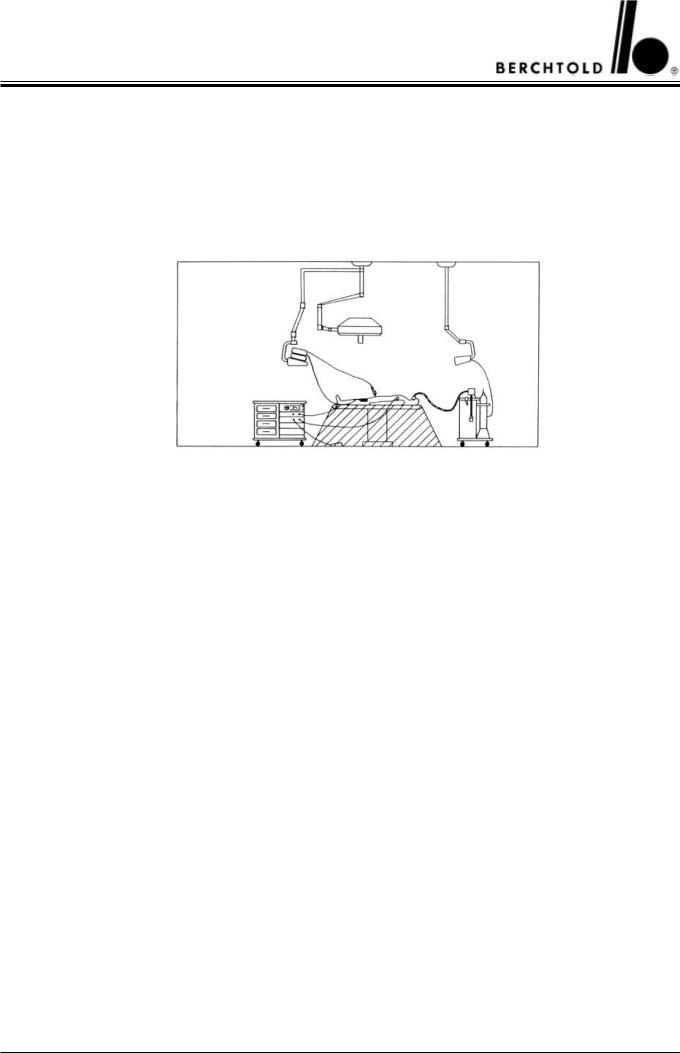
Note:
The use of apparatus isolated against earth (floating input) is always recommended for procedures where there is a direct connection with the heart. All equipment should be of the CF classification.
5.5 The use of foot-switches
Only flash-proof foot-switches may be used in the operating theatre environment. Please examine the underside of the foot-switch to ensure that it is marked for use in the operating environment.
The indicated area is the zone in which inflammable mixtures form an explosive danger when mixed with air. Exhaust anaesthetic, gasses and disinfection fluid vapours, being heavier than air, sink to the floor. For this reason, the indicated zone must be seen as an explosive risk area.
The increasing dilution with air outside the zone decreases the danger of explosion.
6 Surgical indications
.
The ELEKTROTOM has been conceived for use in the following surgical disciplines:
General surgery
Cardiovascular surgery
E.N.T. and faciomaxillary surgery
Paediatric surgery
Laparoscopic surgery
Gynaecological surgery
Plastic surgery
Neurosurgery
10 |
ELEKTROTOM® 610 version 1130 Operating Instrutions |
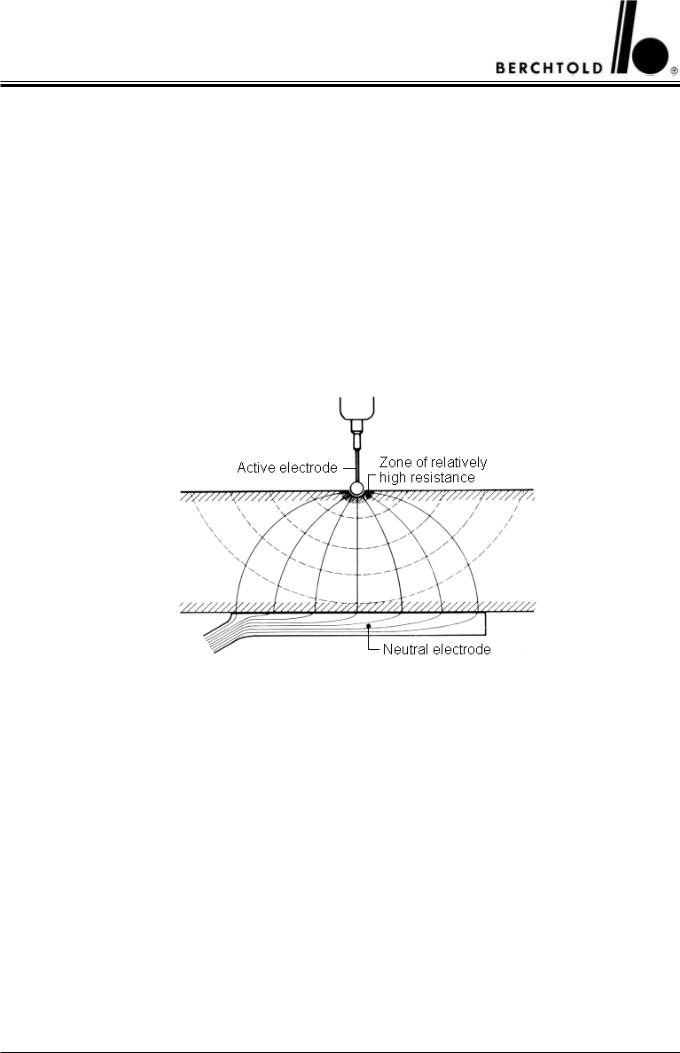
7 Principles of electrosurgery and techniques
.
The principles electrosurgery are basically very simple.
In order to obtain a particular cutting or coagulatory effect, electricity is allowed to enter and flow through the biological tissues. This is aided by the fact that living body tissue is a good conductor of electricity. In order to avoid the undesirable effects of muscle or nerve stimulation, high frequency generators pulse the electricity at such a high rate (over 300 kHz) that the body is not able to react to the stimulus.
7.1 Monopolar techniques
From a small, "active" electrode, high frequency current is introduced into and through the tissues until it exits again via a large, flat electrode called the "negative" electrode. The concentration of electricity and consequent electrical resistance at the (small) point of entry is obviously very much higher than at the large exit point. It is the electrical resistance set up in the area of the active electrode that produces heating of the tissues.
7.1.1 Cutting
At tissue temperatures above 100° C the fluid in the cells evaporates and cause the cell wall to explode. Causing rows of cells to explode will lead to a cut.
In order that HF current can explode enough cells in a short period of time, an incalculable number of electrical discharges (Sparks) are passed to the tissue causing a cutting effect.
That an electrical discharge takes place at each half wave of the high frequency current, a certain amount of power is required. Not enough power causes no discharge and no tissue cutting. Adding more power than is needed to simply cut the tissue allows such a discharge of energy, with each spark, as to cause an additional, coagulatory effect. During a time orientated constant cut, the depth of coagulation increases. This can be compensated for by an increase in the cutting speed.
The functional intensity of the mode is influenced by the modulation of the HF current, and is responsible for the degree of tissue charring. The degree of current modulation is indicated by the crest factor which indicates the relationship between peak and effective voltage.
7.1.2 Coagulation
At tissue temperatures between 60° C and 80° C blood begins to clot, the cell structures change and coagulation occurs.
The ELEKTROTOM® 610 offers soft (low power) coagulation or forced (high power) coagulation.
ELEKTROTOM® 610 version 1130 Operating Instructions |
11 |
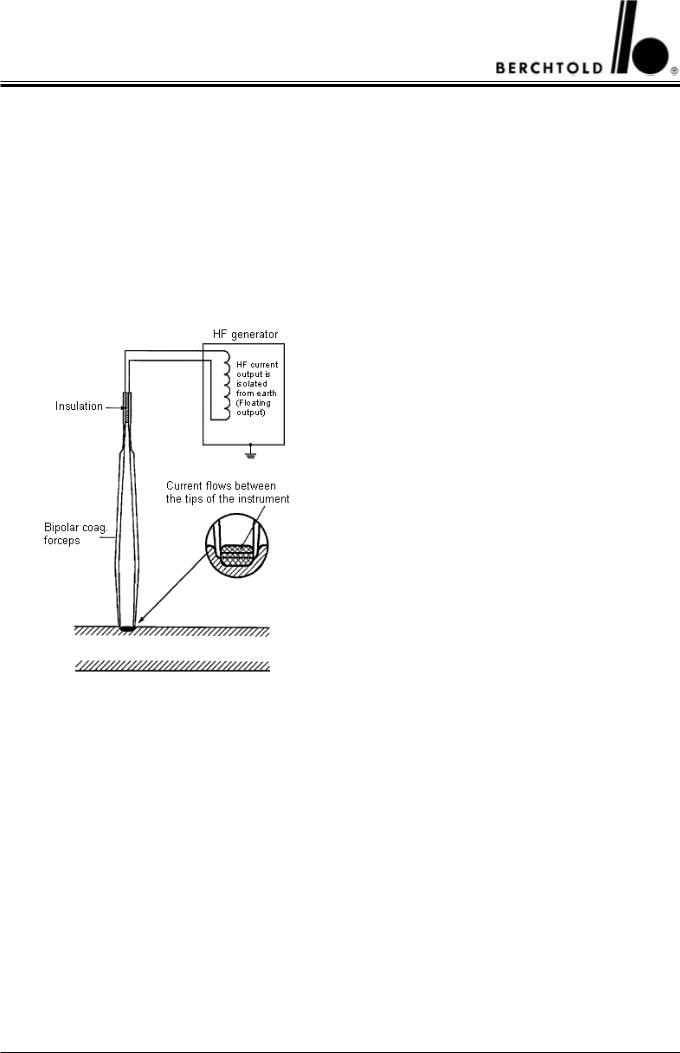
With soft coagulation, stray discharging (sparking) between the active electrode and the tissues is avoided and less energy is imparted to the patient. The subsequent effect is less tissue charring while preventing „sticking“ due to electrode coating. Further, wound healing is not delayed due to the presence of carbonised tissues.
In forced coagulation, high voltage electrical discharging is induced to obtain quick and effective haemostasis in difficult tissues. A degree of active electrode coating is inevitable and care must be taken to maintain the cleanliness of the electrode tip.
7.2 Bipolar techniques
During bipolar procedures, the HF current is no longer passed from an small, „active“ electrode to a large „negative“ electrode but flows between the fine tips of an instrument such as a forceps. Thus, tissue held by the forceps are subject to HF current and become heated.
Bipolar technology is traditionally used to obtain fine and precise coagulation using tweezer-type forceps. This delicate method of coagulation is at home in neurosurgery though a large number of instruments are now available for use in minimally invasive, laparoscopically assisted surgery.
During bipolar electrosurgery, HF current passes between the tips of a specially insulated forceps and the tissues which are held in the (non-insulated) jaws of the instrument. The electrical resistance set up by the tissue causes heat to be produced and haemostasis is obtained.
Bipolar technology is used when the tissue thermal reaction should be kept to a very minimum in order to reduce unnecessary surrounding tissue damage or to reduce the danger of HF current interference to other electrical equipment.
Because of the accuracy and safety of bipolar technology it is ever more at home in neurosurgery, thoracic surgery, open heart surgery, hand surgery and endoscopic surgery.
8 Functions of the ELEKTROTOM® 610
.
8.1 Current types for 2 cutting modes with differing effects
The ELEKTROTOM® 610 provides a choice of 2 cut modes: (see page 20):
•Cut I: pure cut with no coagulation (pressure pad 5)
•Cut II: cut plus coagulation (blend) (pressure pad 6)
The unit output, and subsequent cutting power, can be varied between 5 and 100 Watts, in 5 Watt increments, using the up/down puhsbuttons 9 and 10. Regardless of the cutting speed, electrode geometry or tissue resistance, the actual generated power is automatically controlled to be optimal for the procedure being undertaken.
12 |
ELEKTROTOM® 610 version 1130 Operating Instrutions |
